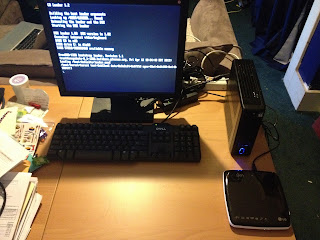1) It's a normal tower form factor. It can easily sit under or on your desk and not be in the way.
2) It's powerful. A simple processor upgrade on my low end sale-model Celeron G550 to a e3-1220v2 makes this a quad-core work horse. Same goes for the ram. It supports up to 32GB of DRR3 ECC.
3) It's quiet. I have it sitting under my desk and can't hear it over my HP micro server.
4) It's well built; the case material feels solid, the internal layout gives plenty of working room, there are two internal USB headers on the motherboard for thumb drives , and it has plenty of PCI-E express slots to add additional network adaptors or a raid controller.
5) It has IPMI or Remote management.
6) It barely sips power. With the latest gen Intel Xeon, 32GB of ram, four hard drives (two SSD/two spindle), and a Intel Pro 1000 PT Quad port NIC, I'm barely drawing 46 watts at idle with half a dozen VM's spooled up. That's nothing! My HP N54l Microserver draws the same amount of power with 6 spindle drives and 1/10th the processing power.
7) It will run anything. Xen, ESXi, Linux, Windows, GN3, it does not matter- it has great driver support. You can add up to 18 NIC ports with 6 port PCI-E nics. You can fill it full of hard drives, install OMNI/ESXi and turn it in to a micro Napp-it all-in-one appliance on the cheap.
8) It has business support. I "loathe" Dell's home support. Business class has always been top notch.
So what's it missing?
First off, I have to knock a solid point off for it having a SINGLE NIC. Really Dell? Even my whitebox Supermicro gear has three (one dedicated IPMI and two gigabit nics). There's plenty of room to add additional though.
Second, and this is more my fault for not spending the extra $20, but it only has four hard drive bays. It would make a great FreeNas/Omni ZFS box if it had 6 + the two 3.5" bays.
Third, the bios is straight out of the 90's. It's just like every other server motherboard thought, so I can't really complain. Having the power state options not be under the power settings menu and instead have it hidden under something completely unrelated is just unnecessarily confusing.
Fourth and finally, it lacks USB 3.0- this can be fixed via addon card, but by the time I add this, an additional NIC, ram, hdd's, and processor- I'm close to $1k in to this box.
It's still a killer little box and one that I hope will last me for years to come. I love the tool-less hard drive trays and that they even included the correct length SATA cables for all four HDD's. The power supply is pretty low rated, but unless you are tossing a dozen spindle drives in here and maxing everything out, I can't see it being a problem. I'm not sure why they still include a DVD rom, I personally would rather have more hard drive bays or save the $10 it costs to add in. This deal pops up every year it seams and similar ones throughout the year. Sure it may be $289 next time, but I would buy another if I had a need for a second lab box.
(Air ducting removed for photo.)



























